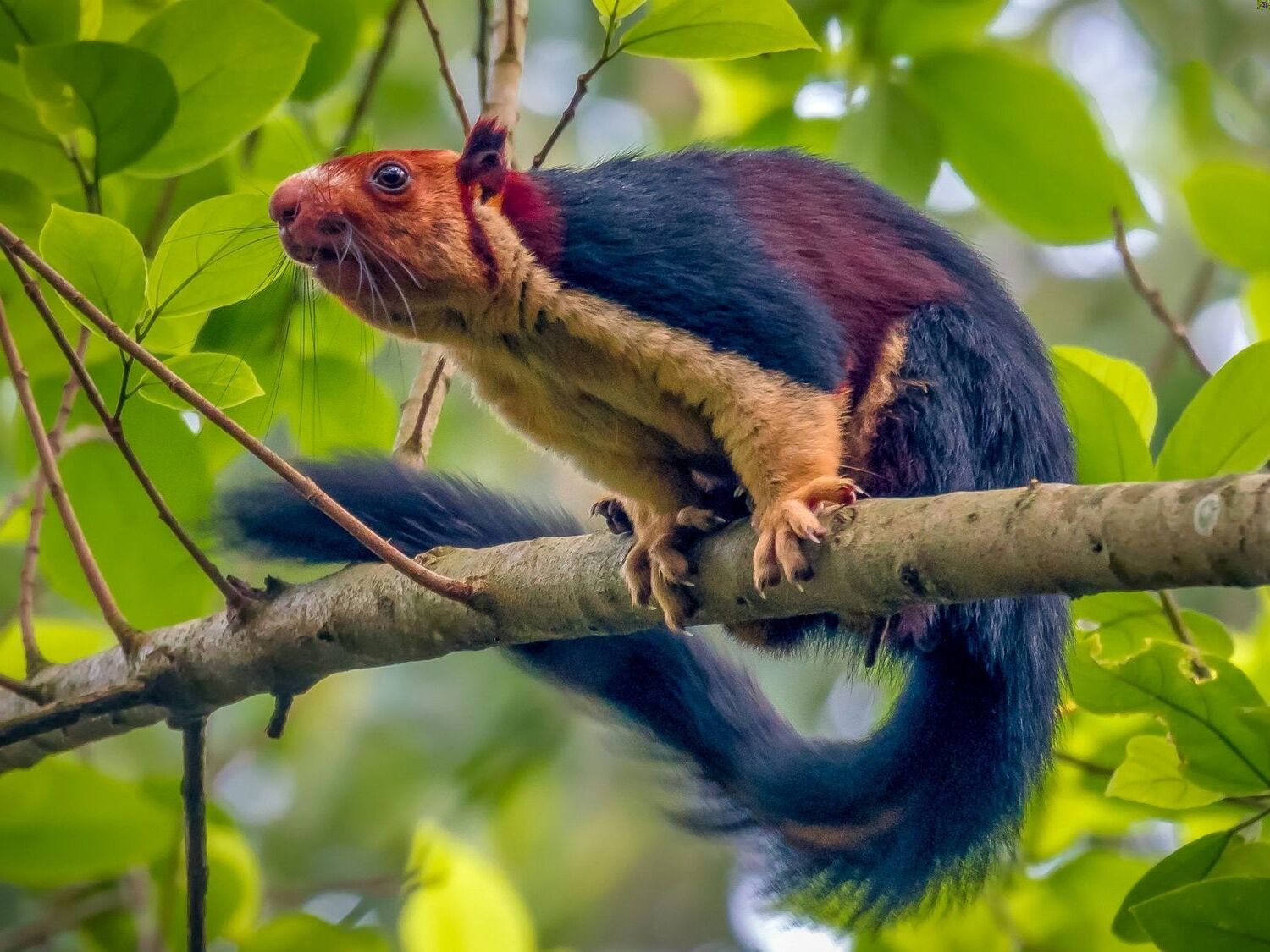
Ever seen a squirrel the size of a cat? Meet the Indian Giant Squirrel, also known as the Malabar Giant Squirrel. This colorful creature, native to the forests of India, can grow up to 3 feet long, including its bushy tail. With fur in shades of maroon, purple, and orange, it looks like it jumped out of a fairy tale. These squirrels are not just pretty faces; they play a crucial role in their ecosystem by spreading seeds and maintaining forest health. Curious about their diet, habits, and unique features? Let's dive into 35 fascinating facts about these incredible animals!
Key Takeaways:
- The Indian Giant Squirrel is a colorful and agile creature, living high in the trees of India's forests. It plays a vital role in its ecosystem by dispersing seeds and promoting forest growth.
- Conservation efforts are crucial to protect the Indian Giant Squirrel from threats like habitat loss and hunting. Its cultural significance and unique behaviors make it a marvel of nature worth preserving.
The Indian Giant Squirrel: A Marvel of Nature
The Indian Giant Squirrel, also known as the Malabar Giant Squirrel, is a fascinating creature native to India. Its vibrant colors and impressive size make it a standout in the animal kingdom. Let's dive into some intriguing facts about this remarkable rodent.
-
The Indian Giant Squirrel is one of the largest tree squirrels in the world, measuring up to 3 feet from head to tail.
-
It boasts a striking coat with a mix of colors, including black, brown, orange, and maroon.
-
These squirrels are native to the forests of India, particularly in the Western Ghats and central India.
-
They are arboreal, meaning they spend most of their lives in trees, rarely coming down to the ground.
-
Their diet consists mainly of fruits, nuts, flowers, and tree bark.
Unique Adaptations and Behaviors
The Indian Giant Squirrel has developed several unique adaptations and behaviors to thrive in its forest habitat. These traits help it survive and flourish in the wild.
-
They have strong, sharp claws that allow them to climb trees with ease.
-
Their long, bushy tails help them balance while navigating through the treetops.
-
These squirrels are known for their incredible leaping ability, capable of jumping up to 20 feet between trees.
-
They build large, spherical nests out of leaves and twigs, usually high up in the canopy.
-
Indian Giant Squirrels are solitary animals, preferring to live alone except during mating season.
Reproduction and Lifespan
Understanding the reproductive habits and lifespan of the Indian Giant Squirrel provides insight into their life cycle and population dynamics.
-
The breeding season typically occurs twice a year, during the pre-monsoon and post-monsoon periods.
-
Females give birth to one to three offspring after a gestation period of about 28 days.
-
The young are born blind and helpless, relying on their mother for nourishment and protection.
-
They reach maturity at around two years of age.
-
In the wild, Indian Giant Squirrels can live up to 20 years.
Conservation Status and Threats
Despite their impressive adaptations, Indian Giant Squirrels face several threats that impact their survival. Conservation efforts are crucial to protect these magnificent creatures.
-
The Indian Giant Squirrel is currently listed as "Least Concern" on the IUCN Red List.
-
Habitat loss due to deforestation is one of the primary threats to their population.
-
They are also at risk from hunting and poaching for their fur and meat.
-
Conservation programs focus on habitat preservation and raising awareness about the species.
-
Protected areas and wildlife sanctuaries play a vital role in their conservation.
Cultural Significance and Human Interaction
The Indian Giant Squirrel holds cultural significance in various regions of India and has interesting interactions with humans.
-
In some Indian cultures, the squirrel is considered a symbol of good luck and prosperity.
-
They are often featured in local folklore and stories.
-
The Indian Giant Squirrel is a popular subject for wildlife photographers and nature enthusiasts.
-
Ecotourism initiatives in India promote the observation and appreciation of these squirrels in their natural habitat.
-
Human activities, such as agriculture and urbanization, can impact their habitats and behavior.
Fun and Lesser-Known Facts
Here are some fun and lesser-known facts about the Indian Giant Squirrel that highlight its uniqueness and charm.
-
They have a keen sense of smell, which helps them locate food.
-
Their large ears can rotate to detect sounds from different directions.
-
Indian Giant Squirrels communicate with each other through a series of vocalizations and tail movements.
-
They play a crucial role in their ecosystem by dispersing seeds and promoting forest growth.
-
These squirrels are known to sunbathe on tree branches, spreading their limbs to soak up the warmth.
-
They can swim if necessary, although they prefer to stay in the trees.
-
Indian Giant Squirrels have a unique grooming behavior, using their front paws to clean their fur meticulously.
-
They are known to cache food in tree hollows for later consumption.
-
Their vibrant colors help them blend into the dappled sunlight of the forest canopy, providing camouflage from predators.
-
Despite their size, Indian Giant Squirrels are incredibly agile and can move swiftly through the treetops.
The Marvel of the Indian Giant Squirrel
The Indian Giant Squirrel is truly a marvel of nature. With its vibrant colors, impressive size, and unique behaviors, it stands out in the animal kingdom. Found primarily in the forests of India, this squirrel plays a crucial role in its ecosystem by aiding in seed dispersal and maintaining forest health.
Its ability to leap great distances and its varied diet showcase its adaptability. Despite its beauty and importance, the Indian Giant Squirrel faces threats from habitat loss and deforestation. Conservation efforts are essential to ensure this magnificent creature continues to thrive.
Learning about the Indian Giant Squirrel not only enriches our understanding of wildlife but also highlights the importance of preserving natural habitats. Next time you think of squirrels, remember the fascinating Indian Giant Squirrel and its vital role in nature.
Frequently Asked Questions
Was this page helpful?
Our commitment to delivering trustworthy and engaging content is at the heart of what we do. Each fact on our site is contributed by real users like you, bringing a wealth of diverse insights and information. To ensure the highest standards of accuracy and reliability, our dedicated editors meticulously review each submission. This process guarantees that the facts we share are not only fascinating but also credible. Trust in our commitment to quality and authenticity as you explore and learn with us.


